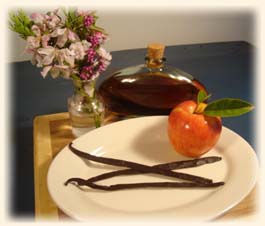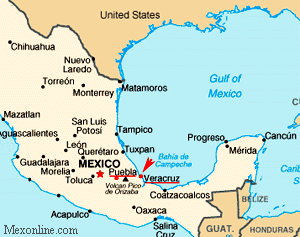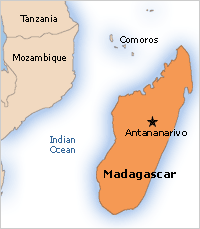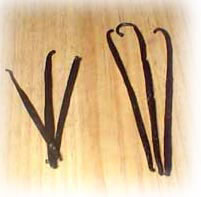
Vanilla Enchantment
Vanilla Products
Make your own Vanilla Extract
|
Vanilla Enchantment | order vanilla beans | Kitchen Projects
The History of Vanilla Beans 
The Peaceful Totonaca Indians of the Gulf coast of Mexico around Vera Cruz were probably the first people to cultivate vanilla.
The Aztecs took their knowledge of growing vanilla and used to flavor their drink that was similar to our chocolate.
Vanilla first left Mexico in the early 1500s on ships bound for Spain . It was originally believed only to have value as a perfume. The Spanish conqueror Herman Cortez met with Emperor Montezuma while seeking treasures of the New World . He observed that the Emperor enjoyed a royal beverage of vanilla-scented chocolate, chocolatl (sometimes referred to as "tlilxochitl" or "xoco-latl").
Cortez was so impressed by this regal drink that when he returned to Europe , he took bags of cocoa and Vanilla along with the gold, silver and jewels of Montezuma's fallen empire. Within half a century, Spanish factories were preparing vanilla-flavored chocolate. For quite some time the Europeans continued to use Vanilla only in combination with the cocoa bean.
Enthusiasts in many regions tried to cultivate Vanilla plants, but the orchids never bore fruit.
The French tired of getting their vanilla from Spain took plants down to the French settlement of the Bourbon Islands (including Madagascar ) They grew well but still the plants would not bear fruit.
The mystery was not solved until 1836, when a Belgian botanist named Charles Morren found that common insects could not pollinate the orchid. |
 |
He observed that a tiny bee, the Melipone, which is found only in the Vanilla districts of Mexico , is uniquely equipped to pollinate the flowers. The bee did not survive outside Mexico . Morren started hand pollinating the blossoms. Then Edmund Albius, a former slave in Madagascar , developed a method of pollinating the Vanilla blossom with a bamboo splinter. This method is still used today in the industry.
|
Where Do Vanilla Beans Come From
| |
Vanilla pods are actually from an Orchid called vanilla planifolla. believe it or not that bears edible fruit. It is a rather small plain yellow orchid that produces these long 7 to 8 inch pods. |
The pods look like green beans and are picked green and need to dry and then ferment to develop that rich flavor. It is a complicated process involving many months , that is why the price is very high.
Even good real vanilla extract will get better with age like a wine. It is the flavor vanillin which is found in the bean the gives vanilla its predominate flavor. Imitation vanilla is made from a wood by product that has vanillin in it.
back to top
What to look for when you buy vanilla beans

in this picture you can see the difference in the beans ...5 inch as compared to the 8 inch beans |
The 3 top varieties of vanilla beans are Madagascar, Tahitian, and Mexican.
You should ask for;
1) premium beans
2) The length, 6 to 8 inch beans are the best.
3) Plump, supple, moist, and glossy, and a rich aroma.
Avoid dry, woody, beans , short , almost no scent. |
Bourbon beans are long and slender, with a very rich taste and smell, have thick, oily skin, contain an abundance of tiny seeds, and have a strong vanilla aroma. Bourbon beans from Madagascar and the Comoros are described as having a creamy, hay-like, and sweet, with vanillin overtones. Bourbon beans from other regions will be similar if they are picked at peak ripeness and are properly cured.
Mexican beans are very similar to Bourbon beans though they have a more mellow, smooth, quality and a spicy, woody fragrance. Tahitian beans are usually shorter, plumper, and contain a higher oil and water content than Bourbon beans.
The skin is thinner, they contain fewer seeds, and the aroma is fruity and floral. They are often described as smelling like licorice, cherry, prunes, or wine. All three types of vanilla are equally good to use though their flavors are quite different. I suggest that you experiment to determine which flavor you most like. Or you may find, as I have, that you will choose beans that best pair with the food or beverage you are preparing. |
Storing Vanilla Beans
Vanilla beans will keep indefinitely in a cool, dark place in an airtight container. Don't refrigerate beans as this can cause them to harden and crystallize. In the humid tropics where beans are grown, they are wrapped in oiled or waxed paper and stored in tin boxes. As I live in a cooler, dryer climate, I keep my beans wrapped in plastic in an airtight plastic tub or glass jar. If you live in a hot humid climate, this isn't a good idea as beans can mildew easily, especially if additional moisture collects in the plastic.
Bourbon beans may develop a frosting of natural vanillin crystals if you keep them for a while. This usually occurs over time and not when the beans are first cured and dried. Called givre in French (which means light frost), these crystals indicate that the beans are high in natural vanillin and are of very good quality. These crystals are quite edible and very flavorful. If you are uncertain whether the beans are covered with crystals or mildewed, take them into the sunlight. The crystals are similar to mineral crystals and will reflect the sun's rays, creating the colors of the rainbow. Mildew, on the other hand, will be dull and flat in the light, and may also smell bad. If the bean is mildewed, throw it away as the mildew will spread to uninfected beans.
|
